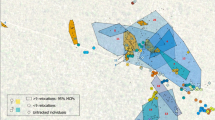Summary
The range use of both sexes of the Aquatic Warbler was studied during two breeding seasons by radio-tracking. Males used home ranges of up to 8 ha. These home ranges over-lapped by up to 74 %, (mean 51 %) between individuals. During the mating period and prior to nesting, females used isolated sites of 2.8 to 6.4 ha (mean: 4.2 ha) within activity ranges of 100 to 160 ha (mean: 120 ha). Home ranges of different females overlapped by up to 20 %. However, during nest-building and incubation, the average size of home ranges in females was only 1.6 ha. Since no constant ranges were observed, we conclude that Aquatic Warblers are not territorial in the breeding season.
Zusammenfassung
In zwei aufeinanderfolgenden Brutzeiten wurde die Raumnutzung von Seggenrohrsängern mittels Telemetrie untersucht. Die ermittelte Größe der Streifgebiete von Männchen betrug in der gesamten Brutzeit bis zu 8 ha. In dem Streifgebiet eines einzelnen Männchens wurden bis zu elf telemetrierte Männchen festgestellt. Die Überlappungen der Streifgebiete telemetrierter Männchen betrugen durchschnittlich 51 %, maximal 74 %. Weibchen nutzten während der Paarungszeit nicht zusammenhängende inselartige Areale von insgesamt 2,8 bis 6,4 ha (Mittelwert 4,2 ha) innerhalb von Aktionsräumen von 110 bis 160 ha (Mittelwert 120 ha). Diese Areale überlappten zu 20 % mit den Aufenthaltsgebieten anderer Weibchen. Während des Brütens sank die Größe der Streifgebiete der Weibchen auf durchschnittlich 1,6 ha. Da im Beobachtungszeitraum keine konstant genutzten Aufenthaltsgebiete vorlagen, schließen wir, daß sich Seggenrohrsänger in der Brutzeit nicht territorial verhalten.
Similar content being viewed by others
References
Alcock, J. (1996): Das Verhalten der Tiere aus evolutionsbiologischer Sicht. Stuttgart.
Birkhead, T. R. (1993): Avian mating systems: The Aquatic Warbler is unique.... Trends Ecol. Evol. 8: 390–391.
Brown, J. L. (1964) The evolution of diversity in avian territorial systems. Wilson Bull. 76: 160–169.
Cramp S. (ed.) (1992): Birds of the Western Paleartic. Vol. VI. Oxford.
Dyrcz, A. (1989): Polygyny in the Aquatic WarblerAcrocephalus paludicola. Ibis 131: 298–300.
Dyrcz, A. & Zdunek, W. (1993): Breeding ecology of the Aquatic WarblerAcrocephalus paludicola on the Biebrza Marshes, northeast Poland. Ibis 135: 181–189.
Dyrcz, A., Wink, M., Backhaus, A., Köppner, C., Zdunek, W., Leisler, B., & Schulze-Hagen K. (subm.): Variability of multiple paternity in the Aquatic WarblerAcrocephalus paludicola.
Emlen, S. T. & Oring, L. W. (1977): Ecology, sexual selection and the evolution of mating systems. Science 197: 215–223.
Heise, G. (1970): Zur Brutbiologie des Seggenrohrsängers (Acrocephalus paludicola). J. Ornithol. 11: 54–67.
Heise, G. (1974): Der Seggenrohrsänger — eine vom Aussterben bedrohte Art. Falke 21: 6–11.
Leisler, B. (1981): Die ökologische Einnischung der mitteleuropäischen Rohrsänger (Acrocephalus, Sylviinae). I. Habitattrennung. Vogelwarte 31: 45–74.
Leisler, B. (1985): Öko-ethologische Voraussetzungen für die Entwicklung von Polygamie bei Rohrsängern (Acrocephalus). J. Ornithol. 126: 357–381.
Leisler, B. (1988): Intra- und interspezifische Aggression bei Schilf- und Seggenrohrsänger (Acrocephalus schoenobaenus, A. paludicola): ein Fall von akustischer Verwechslung. Die Vogelwarte 34: 281–290.
Møller, A. P. (1987): Intruders and defenders on avian breeding territories: the effect of sperm competition. Oikos 48: 47–54.
Murray, B. G. jr. (1969): A comparative study of the Le Conte's and Sharp-tailed Sparrows. Auk 86: 199–231.
Naef-Daenzer, B. (1993a): A new transmitter for small animals and enhanced methods of homerange analysis. J. Wildl. Manage. 57: 680–689.
Naef-Daenzer, B. (1993b): GRID, calculations for home-range and spatial data analysis. Swiss Ornithol. Inst. Sempach, Schweiz.
Noble, G. K. (1939): The role of dominance in the social life of birds. Auk 56: 263–273.
Post, W. & Greenlaw, J. S. (1982): Comparative costs of promiscuity and monogamy: A test of reproductive effort theory. Behav. Ecol. Sociobiol. 10: 101–107.
Rappole, J. H. & Tipton., A. (1990): New harness design for attachment of radio transmitters to small passerines. J. Field. Ornithol. 62: 335–337.
Rodrigo-Rueda, F. J., Rodriguez-Teijero, J.D., Puigcerver, M. & Gallego, S. (1997): Mate switching in a non-monogamous species? The case of the Common QuailCoturnix coturnix. Ethology 103: 355–364.
Rolando, A., Cavallini, P., Cursano, B. & Olsen, A. (1995): Non-territorial behaviour and habitat selection in the jayGarrulus glandarius in a Mediterranean coastal area. J. Avian Biology 26: 154–161.
Schoener, T. W. (1968): Sizes of feeding territories among birds. Ecology 49: 123–141.
Schulze-Hagen, K. (1991):Acrocephalus paludicola — Seggenrohrsänger. In Glutz von Blotzheim, U. & Bauer, K. (eds.): Handbuch der Vögel Mitteleuropas, 12: 252–291, Wiesbaden.
Schulze-Hagen, K., Swatschek, I., Dyrcz, A. & Wink, M. (1993): Multiple Vaterschaften in Bruten des Seggenrohrsängers: Erste Ergebnisse des DNA-Fingerprinting. J. Ornithol. 134: 145–154.
Wawrzyniak, H. & Sohns, G. (1977): Der Seggenrohrsänger. Wittenberg-Lutherstadt.
Author information
Authors and Affiliations
Rights and permissions
About this article
Cite this article
Schaefer, H.M., Naef-Daenzer, B., Leisler, B. et al. Spatial behaviour in the Aquatic Warbler (Acrocephalus paludicola) during mating and breeding. J Ornithol 141, 418–424 (2000). https://doi.org/10.1007/BF01651571
Accepted:
Published:
Issue Date:
DOI: https://doi.org/10.1007/BF01651571



